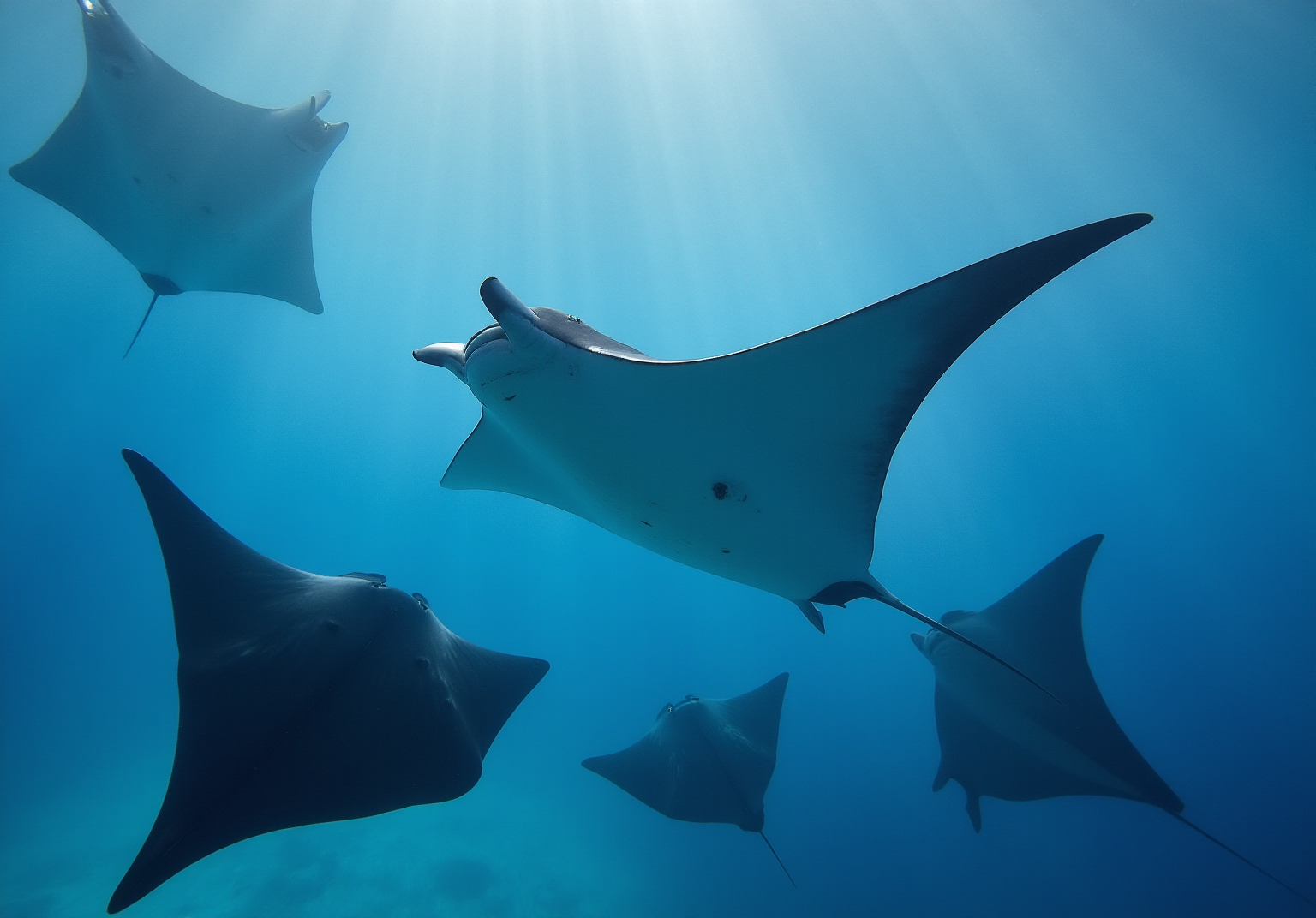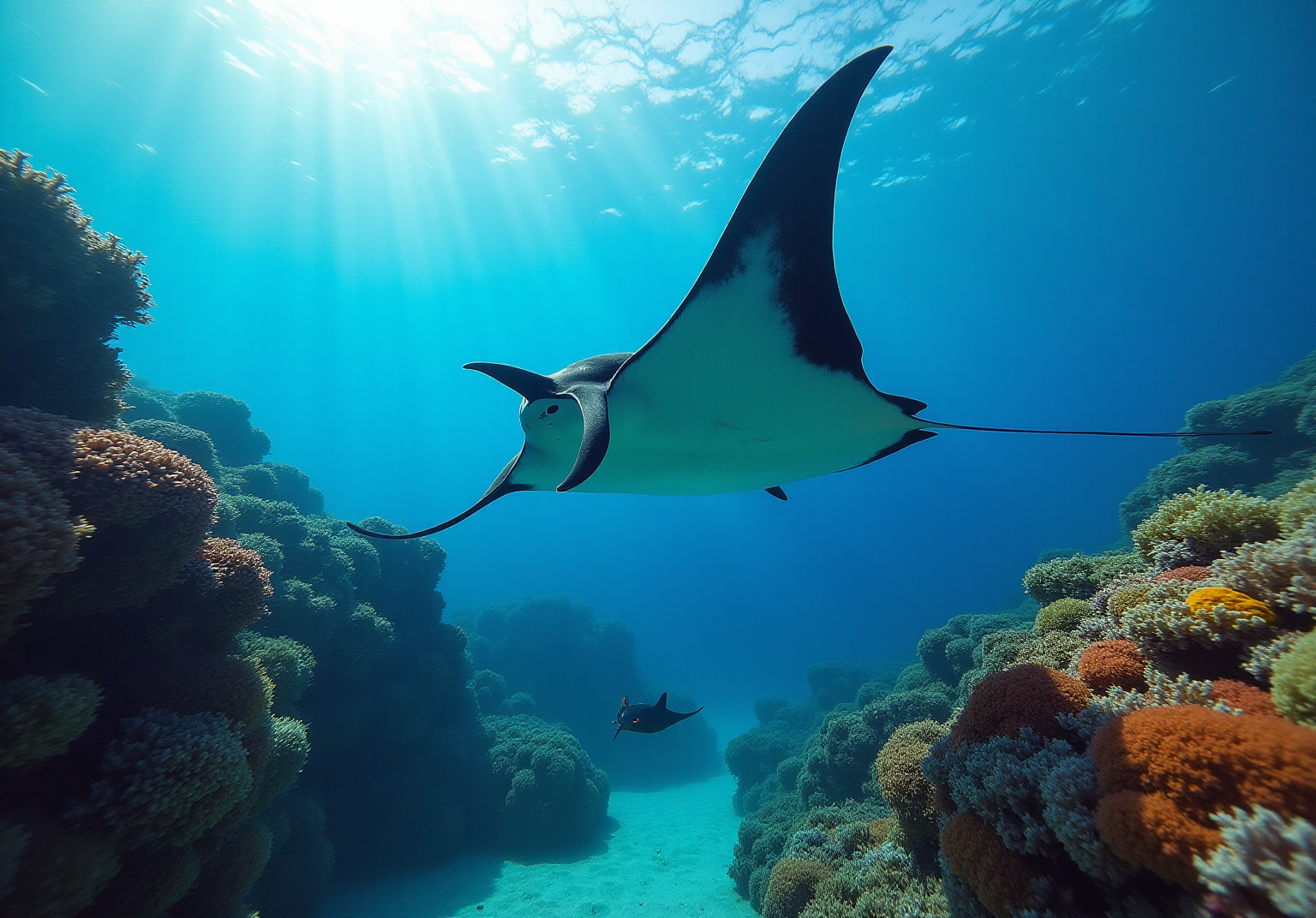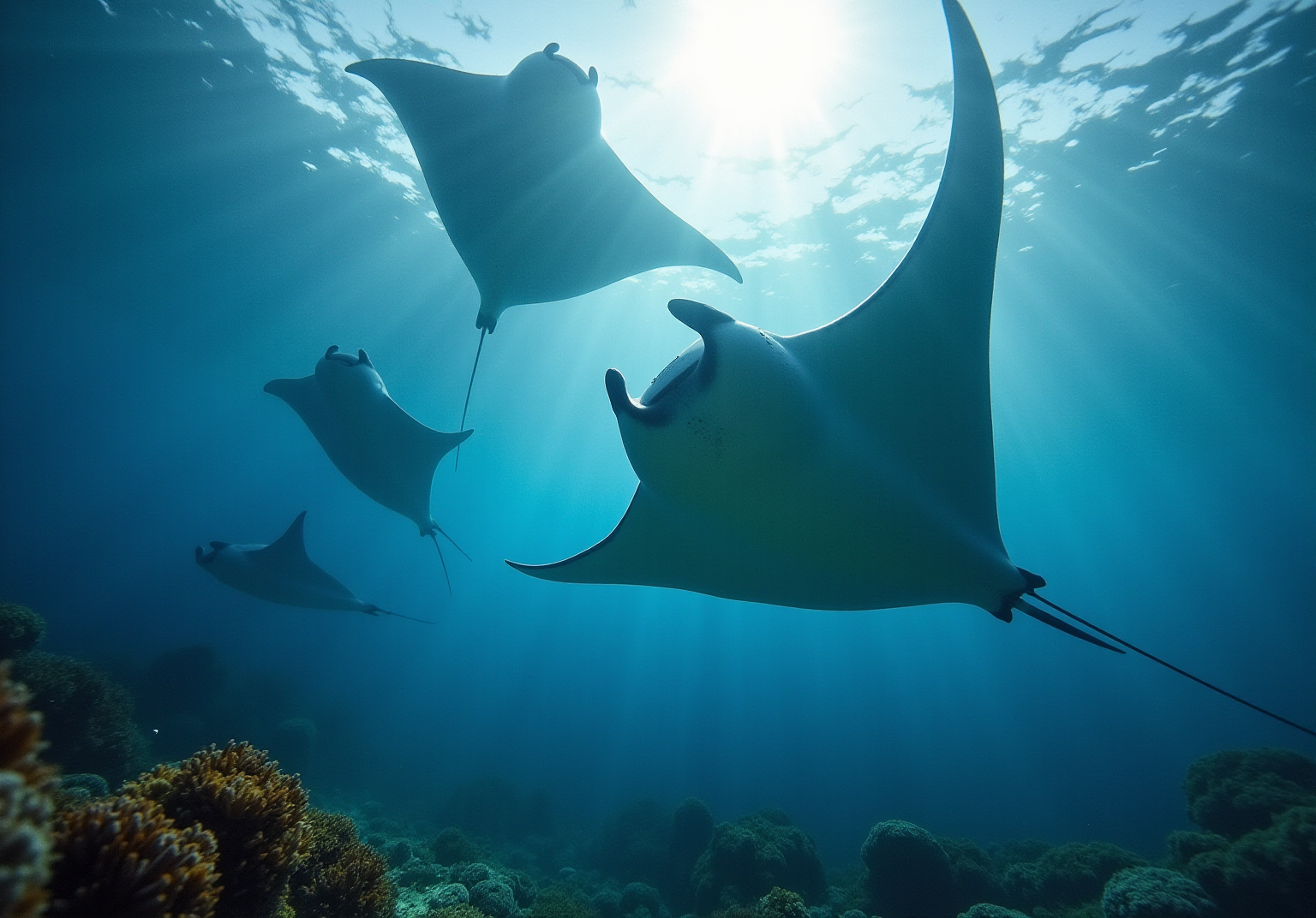Overview
Imagine gliding through crystalline waters, where the graceful silhouette of a manta ray emerges, its flat body a testament to the elegance of evolution. These gentle giants, with their expansive wingspan, play an essential role in the marine tapestry, filtering through the ocean’s depths to maintain the delicate balance of plankton populations and nurture the vibrant coral reefs that teem with life. Yet, beneath this serene surface lies a pressing urgency; the article unfolds the narrative of their plight, revealing the shadows cast by overfishing, habitat degradation, and the relentless march of climate change.
As we delve deeper, the scene becomes richer, filled with the echoes of conservation calls that resonate across the globe. Each manta ray is not merely a creature of beauty but a vital thread in the fabric of our oceans, deserving of protective measures and collective action. Picture the vibrant coral reefs, alive with color, thriving under the care of these magnificent beings, a reminder of the interconnectedness of life beneath the waves. The urgency of their conservation reflects not just a need for survival, but a commitment to preserving the very essence of marine health for future generations.
In this moment of reflection, we are left with a profound insight: the survival of manta rays is intertwined with our own stewardship of the ocean. As we contemplate the delicate balance of ecosystems, let us carry forward the message of conservation, ensuring that these majestic creatures continue to grace our seas, a symbol of the beauty and fragility of life that demands our respect and protection.
Introduction
Imagine a world beneath the waves, where graceful manta rays glide effortlessly, their expansive wingspans creating a mesmerizing dance in the ocean's depths. Picture the sunlight filtering through the water, illuminating their elegant forms as they navigate the currents with an ethereal grace. These magnificent creatures, stunning to behold, play a critical role in maintaining the delicate balance of marine ecosystems.
Yet, as their populations face alarming declines due to human activities and environmental challenges, we must ponder: what steps can be taken to ensure their survival?
This article delves into the fascinating world of manta rays, exploring their unique characteristics, ecological importance, and the urgent conservation efforts needed to protect these extraordinary beings.
Define Manta Rays: An Overview of Their Characteristics
Imagine gliding through azure waters, where the majestic manta rays, known for their expansive wingspans of up to 26 feet, embody what is a manta as they dance gracefully beneath the surface. These large, flat-bodied fish, which are often referred to as what is a manta, embody the essence of the ocean's grandeur. The giant Mobula (Mobula birostris) and the reef Mobula (Mobula alfredi) illustrate what is a manta, as they are not only creatures of size but also symbols of evolutionary wonder, having been reclassified in 2017 to highlight their significance in our marine ecosystems. With broad, diamond-shaped bodies and triangular pectoral fins, their unique cephalic lobes serve as tools for feeding, as they filter zooplankton, weaving their role into the fabric of oceanic life.
As you immerse yourself in this underwater realm, recent studies reveal the intricate social behaviors of these magnificent beings, particularly the giant variety. Picture a vibrant scene where rays gather in groups, engaging in feeding and mating rituals, a testament to their complex social structures. A notable case study from the Gulf of Mexico unveiled a thriving ray nursery, highlighting the urgent need to protect these vital habitats. The discovery of the newly recognized species, Mobula yarae, echoes the continuous revelations in ray research, crucial for shaping effective conservation strategies.
The Marine Megafauna Foundation (MMF) stands as a guardian of these extraordinary species, dedicated to unraveling their habitat needs and movement patterns, especially in areas impacted by human activities like boat traffic and coastal development. Jessica Pate, founder of the Florida Project, poignantly states, "Understanding their habitat needs and movement patterns is crucial for their protection." The threats posed by vessel collisions and fishing entrapments loom large, making preservation initiatives not just important but imperative for their survival. Through ongoing research, including satellite tagging and population monitoring, we can illuminate the path toward conservation, ensuring the continued existence of these remarkable creatures, whose graceful presence captivates all who encounter them.

Explore the Taxonomy and Classification of Manta Rays
Imagine gliding through azure waters, where the gentle sway of the ocean cradles the majestic rays of the genus Myliobatiformes. These creatures, part of a vast order that encompasses a variety of rays and skates, embody the grace of the sea. Classified under the family Mobulidae, they invite us to explore their world, where recent genetic research has unveiled a remarkable transformation: what is a manta has evolved from a singular genus into two distinct genera. Here, the smaller Mobula dances alongside the larger Manta, each occupying their own ecological niche.
As you delve deeper, picture the giant ray (Mobula birostris) soaring through the open ocean, a sentinel of the deep, while the reef ray (Mobula alfredi) finds solace in the embrace of coastal habitats. This classification not only reflects their evolutionary adaptations but also whispers tales of the diverse environments they inhabit. The giant ray, with its expansive wingspan, glides effortlessly in the vastness, while the reef ray weaves through vibrant coral gardens, each movement a testament to the beauty of adaptation.
In this underwater realm, we are reminded of the delicate balance of nature and the intricate tapestry of life. Each ray, a living embodiment of the ocean's wonders, invites us to reflect on our connection to these magnificent beings and the ecosystems they represent. As we gaze into the depths, we are left with a lingering sense of awe, a reminder of the extraordinary diversity that thrives beneath the surface, waiting to be discovered.

Understand the Ecological Role and Conservation Challenges of Manta Rays
Imagine gliding through the crystalline waters of the ocean, where the graceful manta rays, which lead to the question of what is a manta, dance beneath the surface, their wings unfurling like delicate silk. These magnificent creatures are not just a sight to behold; they play an essential role in the marine ecosystem as filter feeders, meticulously regulating plankton populations and sustaining the intricate balance of oceanic food networks. Their feeding habits contribute to nutrient cycling, a lifeline for the health of coral reefs and other vibrant marine habitats.
Yet, as we marvel at their beauty, we must confront the sobering reality of their plight. These large marine animals face considerable conservation challenges:
- overfishing
- bycatch in commercial fisheries
- habitat degradation
- climate change
- the insidious threat of plastic pollution
Each of these factors has led to a decline in their populations, prompting conservation organizations to rally for protective measures. Initiatives such as marine protected areas and sustainable tourism are not merely strategies; they are lifelines for the survival of these extraordinary beings and the ecosystems they inhabit. In the Maldives, where the world’s largest population of reef manta rays thrives—over 5,000 individuals have been counted—targeted conservation efforts take on profound significance.
As advocates push for the uplisting to CITES Appendix I, a coalition of governments and NGOs aims to prohibit all commercial international trade of these creatures, underscoring the collaborative spirit necessary for effective conservation. The slow reproductive rates of mobulids render them especially vulnerable to population declines, heightening the urgency for immediate action. Without such measures, we risk losing not just these remarkable species but also the delicate ecological balance they help maintain. On World Manta Day, we find a platform for raising awareness and advocating for the protection of manta rays, which prompts us to consider what is a manta and reminds us that global action is not just necessary; it is imperative.

Conclusion
Manta rays glide through the azure depths, their impressive wingspans unfurling like the sails of a majestic ship, embodying grace and elegance. These remarkable beings are not merely spectacles of the ocean; they are vital threads woven into the intricate tapestry of marine ecosystems. To truly appreciate what constitutes a manta, one must delve into their unique characteristics, ecological roles, and the pressing conservation challenges that threaten their existence. As this narrative unfolds, it becomes clear that these magnificent creatures are essential for maintaining the delicate balance of ocean life.
Immersed in the discussion, we uncover the taxonomy of manta rays, their intricate social behaviors, and the myriad threats they face—overfishing, habitat degradation, and climate change loom large. The tireless efforts of organizations like the Marine Megafauna Foundation illuminate the path toward their conservation, underscoring the importance of research and protective measures. In this delicate dance of survival, the urgent need for global action resonates, especially considering their slow reproductive rates, which heighten the stakes.
As the plight of manta rays unfolds before us, it beckons a collective response to safeguard their future. Imagine advocating for marine protected areas, supporting sustainable tourism, and raising awareness on platforms like World Manta Day—each step is a vital contribution to ensuring these extraordinary creatures continue to thrive. The survival of manta rays is intricately linked to the health of our oceans, reminding us that protecting these gentle giants transcends environmental concern; it is a shared responsibility that binds us all.
Frequently Asked Questions
What are manta rays and their main characteristics?
Manta rays are large, flat-bodied fish known for their expansive wingspans of up to 26 feet. They have broad, diamond-shaped bodies, triangular pectoral fins, and unique cephalic lobes that help them filter zooplankton for feeding.
What species of manta rays are mentioned in the article?
The article mentions two species: the giant Mobula (Mobula birostris) and the reef Mobula (Mobula alfredi), as well as a newly recognized species called Mobula yarae.
What social behaviors do manta rays exhibit?
Manta rays, particularly the giant variety, exhibit complex social behaviors, gathering in groups for feeding and mating rituals, which highlights their intricate social structures.
Why is the Gulf of Mexico significant for manta rays?
The Gulf of Mexico is significant because it contains a thriving ray nursery, emphasizing the need to protect these vital habitats for manta rays.
What organization is dedicated to the conservation of manta rays?
The Marine Megafauna Foundation (MMF) is dedicated to studying and conserving manta rays, focusing on their habitat needs and movement patterns, particularly in areas affected by human activities.
What threats do manta rays face?
Manta rays face threats from vessel collisions and fishing entrapments, which pose significant risks to their survival.
How can research contribute to the conservation of manta rays?
Ongoing research, including satellite tagging and population monitoring, helps illuminate habitat needs and movement patterns, which is crucial for developing effective conservation strategies for manta rays.




